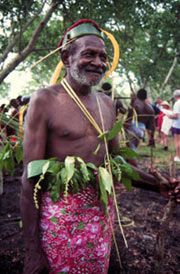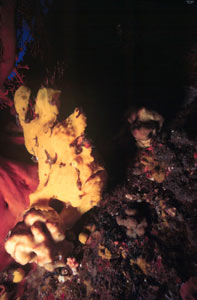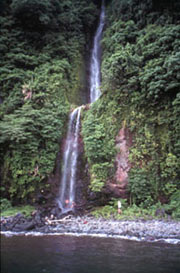We're back in Fiji with five weeks worth of tales to tell about new places and encounters abroad.
IN SUMMARY
Overall, the NAI'A in Vanuatu season was a pioneering success and
has inspired all kinds of plans to try to return for another series
of trips in the future.
NAI'A did three 10-day trips around Vanuatu and each of them was unique.
The first featured Paul Humann as our special guest presenter and
the second and third put Stan Waterman in the spotlight.
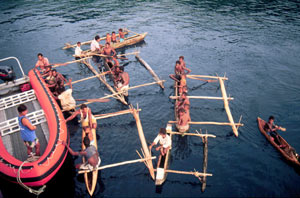
Every group was keen to explore unknown territories so by the end of the season we had glimpsed almost ever corner of Vanuatu. During the first charter we loosely followed the old Coriolis itinerary as a guide(constantly finding diversions) moving from Port Vila to Emae up the east side of Epi, the west side of Malekula and finishing in Espiritu Santo. On the second trip, favorable conditions and a last minute decision took us way north into the remote Banks Islands and then a long series of passages back south to end in Vila. The third trip presented a whole new set of options and gave us a look at the eastern stretch of islands from Ambrym, to Pentecost, to Maewo and Aoba.
HIGHLIGHTS
Early on we realized that Vanuatu was not going to be another Fiji in that the reefs were not as lavishly decorated with soft corals and swarms of colorful fish. However, once we looked with fresh and open minds we found many unique and very different opportunities - which was of course the reason we all came!
Tongoa Wall (Tongoa Island) was absolutely hands down the prettiest stretch of reef in terms of soft corals - including the most astonishing spread of giant black coral trees reaching farther down than even the most daring eye could see. It was a great dive on the first trip even in poor conditions. But later on in clearer calmer water it was among the very best diving scuba can provide. Trouble was, the currents on one occasion ripped so hard that even I was forced admit defeat and abort the whole dive for everyone - but that was under a hellish rain squall. Across the channel, the black sand bottom of coral bommies, Jacob's Canes and brightly colored butterfly, angel and trigger fishes (their patterns really leap out against the black sand) was an unusual variation on the theme. Tough for photography.
Outrageous critters such as the gargantuan football-sized bright yellow frogfish or the orgy of mating cuttlefish at Hat Island were overwhelmed by two astonishing night dive encounters. On the first trip, a few hardy night divers were rewarded with several live nautilus visiting the shallows at 20 feet up from their regular depth of more than 1000 feet! Mingling with Spanish dancers, they brought to the brown boulder bottom a "holy" unexpected significance! But in term of sheer spiritual enlightenment, the night dive to 130 feet (max) on the Henry Bonneaud shipwreck made believers and mystics of even the most pragmatic and experienced of us. Astronauts floating in space have nothing on the feeling of diving weightless (torches off) amid thousands of pulsing flashlight fish. The full moon on the second trip seemed to bring out much larger numbers and it so moved us we went back for a second sermon the following evening.
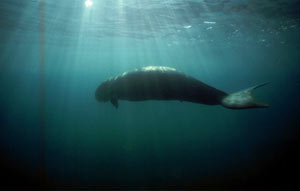 |
| Dugong |
Big animal encounters are hit and miss anywhere and Vanuatu did not reveal too much in the way of giant pelagics. I got lucky on trip #1 with a curious pod of bottlenose dolphins who buzzed and circled me after several of us jumped off the back deck early one morning. (They must have known it was my birthday!) In fact, we saw many pods of dolphins throughout the three expeditions. A skiff load of divers on trip #3 persevered with a very large pod of Pacific spotted dolphins and got to tow in the wake as the animals led our skilled driver Bale out to sea. On what was supposed to be a macro dive, we girls (trip #2) were taunted by a huge dugong who didn't stick around to pose for pictures. While others shot about 30 minutes of video from every possible angle of a massive Queensland grouper (Boris' girlfriend?) who refused to move even with wide angle lenses right up against her luscious lips. While we didn't find any large groups of sharks, someone (or all) usually spotted on average one or two gray reef sharks at most sites. Often young pups were the curious ones. White tips were neither common nor rare. A couple of silvertips buzzed in for a look, an unidentified huge shark shocked several divers on one dive and a beautiful old leopard shark lured others back down to the bottom for a closer look. We encountered some dogtooth tuna, Spanish mackerel, rainbow runners and giant trevally but we were surprised to find relatively few schools of barracuda and jack.
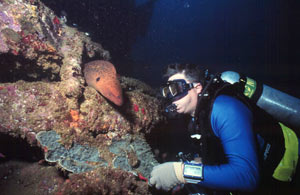
Moray
The President Coolidge was our sure-thing and during each trip we included two diving days in Santo on the huge shipwreck. Thanks to Kevin, Mayumi and their staff from Aquamarine, these Coolidge dives were truly stupendous. Some took to the deep penetration journeys and long decompression stops. Others explored outside the wreck and spent more time fooling around with Boris the grouper, the pett-able moray eels and the infinite macro critters at the "Coral Garden" including ghost pipefish, baby crocodilefish, leaf scorpionfish, twin-spot gobies, bizarre nudibranchs and all manner of shrimp. This place is not only an oasis for fish and invertebrates it's a veritable zoo where the animals are so used to being handled and/or fed they hover around the dozens of streams of bubbles unperturbed. NAI'A divers on trip #3 had the good fortune to witness the Return of The Lady to the Coolidge.
Offshore pinnacles on the western edges of several islands revealed spectacular gardens and terraces of hard corals, gullies of gorgonians and excellent fish life. The western sides are the lee sides in prevailing trade winds, offering corals protection from the onslaught of wind-driven waves and swells. And their position slightly away from the fringing reef both encouraged current flow around the edges and ensured rain and run-off did not engulf the corals with silt and soil. At such a reef off Santa Maria in the Banks group, we discovered great swaths of anemone fields teeming with anemone fishes and porcelain crabs, giant chromodoris (nudibranch) sex-fests and huge gorgonians covered in ovulids. At another near Epi, the currents drove us into gatherings of Goldman's and oriental sweetlips and over delicate and dangerously wide scopes of brightly colored fire corals. Definitely, no where to stop and hold on!
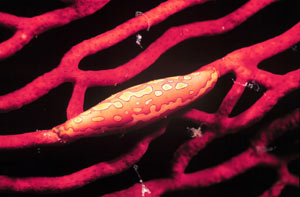
Other favorite fringing reefs were Maewo's exceptionally pretty shallow hard corals (hiding octopus and cuttlefish), schooling anthias and 60-ft depth flats of short neutral toned soft coral trees. Prolific staghorn slopes at Araki and Tuvana grew in blue, yellow, lavender and rose - gleaming in the beautifully clear water. Below the 80 foot mark were some of the most enormous and perfectly-formed sea fans any of us had ever seen - and lots of them - all along the steep sloping edge of the islands. One particularly blue anemone got more than it's fair share of attention. While the chief from Araki charmed everyone with his interest in underwater video and his newfound penchant for preserving the reefs and driving fisherman away. He also told us about a great way of predicting the future: walk to the top of his island, find a particular leaf that has good aerodynamic properties and throw it out into the wind. If it lands in the sea you will die from drowning. If it lands on the ground you will be murdered. If it reaches the roof of a house you will die in your bed. If it lands on pandanus you will be poor. And if it lands on a Banyan you will marry, have sons and daughters and be rich. Why didn't someone tell us that before...
WEATHER & CONDITIONS
Weather is pure luck. We were blessed by a conspicuous lack of cyclone
conditions - or even much in the way of wind. (Sad for us as were
rarely ran the sails up our new mast!) The first group suffered the
worst weather with rain aplenty and some big ocean swells from ever-varying
directions. Through the middle we enjoyed calmer seas, more sun and
much better visibility. Then near the end of the third trip the weird
northerly ocean swells returned and forced us to explore the normally
windward sides of islands. As expected, sadly, those windward sides
often looked like they were constantly hammered by swells.
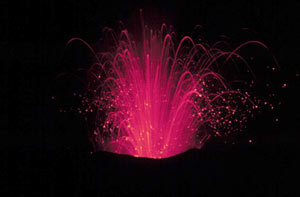
One reason were were attracted to exploring Vanuatu turned out to be the same element that caused us problems. Unlike Fiji, Vanuatu is mostly high volcanic and densely wooded islands surrounded by fringing reef that falls away quickly into extremely deep water. Sounds dramatic? It is gorgeous! But it also leaves the fringing reef extremely vulnerable to changing weather and water conditions. In dry weather, the water was clear but as soon as the rain came down, the run-off from numerous rivers and waterfalls chronically mucked up the reefs. Also, all this deep indigo water close to shore looks stunning but unless we could find enclosed shallow bays or protective peninsula's, we had trouble finding NAI'A an anchorage in which she did not roll. Once we drove into what looked like the ideal anchorage but were forced to turn around after the captain took NAI'A almost to shore but still couldn't get a depth reading on the sounder! With no barrier reefs to protect us we were often at the mercy of ocean swells from several different directions. This got Rob day-dreaming about big shallow draft catamarans...
DISAPPOINTMENTS
- Striking out three times with Epi's "tame" dugong. Even the time we did see him, he wouldn't play.
- Santo's famous shark feed became a flop thanks to the idiots from a resort who decided to catch and kill the sharks to "protect" their guests. That's a battle that has just warmed up.
- Finding Dixon Reef to be considerably less impressive than it was in Coriolis days.
- Having to spend more time than anticipated seeking permission to dive from local chiefs. Sometime there were long-held disputes over reef ownership. But other times (such as at Pentecost) the chiefs simply forbade us from diving at any price because the reefs were under a 10-year protection program. Bad for us, but you've got to respect that kind of thinking.
TOPSIDE BLISS BOMBS
- Mesmerizingly beautiful mountainous island scenery - especially at sunset with hundreds of flying foxes winging across the sky.
- Friendly curious local folks who helped make easier and fun the grueling task of organizing logistics on exploratory voyages.
- Wonderful cultural experiences of Melanesian hospitality and "kastom" dances.
- The feeling of cruising into the magnificent flooded caldera bay at Ureparapara and being met by fleets of wooden outrigger canoes loaded with wide-eyed waving children. Actually, the welcoming canoes were at all the outlying islands!
- All shapes and sizes of waterfalls tumbling onto rocky shores or directly into the sea. The first small one we saw was neat. The second one was so huge everyone got out of bed early just to look. Then as we drove along that coast we counted a dozen more within the hour. By the end of the trip we had long since lost count of the stunning waterfalls throughout Vanuatu.
- Seeing the smoke in day or the glow at night from erupting volcanoes.
- Seeing landslides happen - an earthquake or volcanic venting?
- Shuddering over the top of the spewing, roaring natural fireworks of Tanna's volcano.
- Surviving the 4WD car ride to and from the Tanna Volcano.
